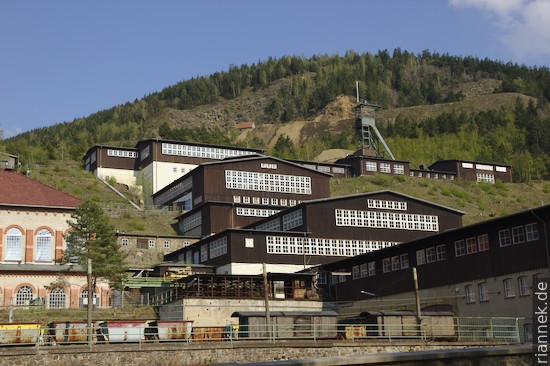
An important type of hydrothermal deposits are sedimentary exhalative deposits (SEDEX), which are formed at hot springs on the seabed, in sedimentary basins far from volcanism. The hot water rises along faults and mixes with the cold seawater, abruptly precipitating sulphides such as pyrite, galena and sphalerite, and sulphates such as anhydrite and barite. Since clay minerals are typically sedimented at the same time, a mudstone is formed that contains large amounts of sulphides. More than half of all known reserves of lead and zinc as well as significant amounts of silver are found in such SEDEX deposits.
One of the world’s most important examples of this type of deposit is the Rammelsberg near Goslar, on the northern edge of the Harz Mountains in Germany. In the folded-in Devonian mudstones, there are two large ore bodies, which contained almost 30 million tonnes of ore with an unusually high grade (14 % zinc, 6 % lead, 2 % copper, 140 g/t silver, 1 g/t gold). Sporadic mining probably began as early as the Bronze Age. From the first written mention in 968 AD, mining was carried out continuously for more than 1000 years. At first, the main focus was on copper (from which, for example, many bronze works of art of the Romanesque period were made) and silver, later also on the other metals as well as on barite. During the Nazi era, a new shaft, a new processing plant and the use of forced labour made it possible to significantly increase the extraction rates… Mining ceased in 1988, and the deposit was completely mined out. Since then, the deep parts of the mine have been flooded (although the cavities were filled with backfill anyway, so that the pillars in between could also be mined). The dry part can be visited in a worthwhile visitor mine.
More about SEDEX in general and the Rammelsberg in particular is explained in my book on mineral deposits. Working on the book was also a reason for me to stop in Goslar. I take three guided tours, visit the museum extensively and am thus kept busy for a whole day. One tour leads through the 200-year-old Röderstollen. Water was fed into the mountain through this tunnel to drive four underground water wheels. Two of them lifted large buckets full of ore from deeper levels, the other two drove pumps that pumped the mine water from the deeper levels. On the next tour, I take the mine train to a more modern part of the mine. An exhibition has been set up around the Richtschacht, where drilling equipment and hoisting machines are demonstrated. The last tour takes us through the processing plant, past huge jaw crushers, ball mills, flotation cells and machines for drying the ore concentrates – a huge accumulation of rusty metal.